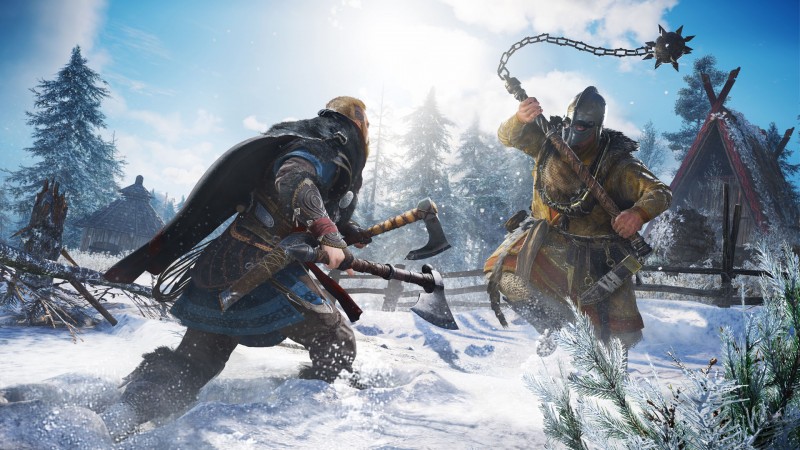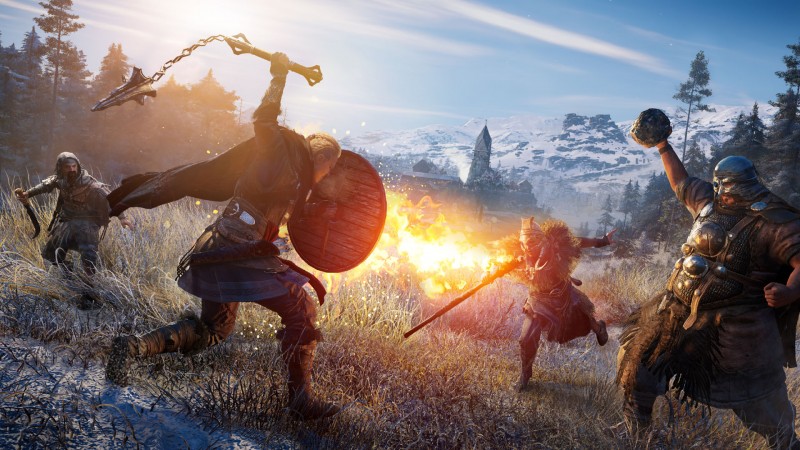
Ubisoft Montreal has many years of experience working on the Assassin’s Creed franchise, but the studio isn’t known for taking small steps. From reimagining exploration with Black Flag to formalizing the series’ RPG status with Origins, we’ve come to expect more than incremental improvements from this team. That trend continues with Assassin’s Creed Valhalla, which brings familiar pillars together in clever ways to surprise new and old fans alike. We talked to producer Julien Laferrière about the big changes, the post-launch priorities, and the decisions that went on behind the scenes during the development of this Viking saga.
What has surprised you most about people’s response so far?
I’ll start with the part that I hoped people would get. We invested a lot of effort in the settlement, which was a central piece of the game. Even internally, when we were developing it, it was the center of a lot of things. But to validate the fact that it has the weight we were expecting, you kind of have to build the whole game and see it ... So I was really looking forward to seeing the reception, and I was really happy just to see people were getting it and enjoying it.
But what surprised me most was this: We introduced world events in this game to compensate for the change in structure with the settlement, and I was really hoping players would get it, but I didn’t expect players to dig it so much. Because [the world events] play a lot with the tone – sometimes it’s almost a joke. It’s funny. Like, there’s a character who has an axe in his head. It’s silly when you think about it; we would never make a main quest about a guy with an axe stuck in his head! The world events were designed as a valve to let off some steam for quest designers who have a bunch of good ideas – all those little narrative moments that didn’t fit into other places in the game.

How did the team land on the idea of using the settlement as a hub?
We knew we would be changing the game structure, which came after a reflection on what we did with Assassin’s Creed Origins: “We created all these characters, and some of them are not memorable. Why is that? They look cool, their script is cool, their performances are cool. Why don’t they get their hooks in players?” We found that because of the way Origins was built – and Odyssey was the same – you unfog the map progressively, and usually you never go back to a part of the map you’ve explored. And the characters are tied to those specific areas of the map. So we were like, “What if we added a place which is a sort of anchor, where you could see the consequences of the decisions you’ve made, and the NPCs you met? For me, it started with trying to have more memorable characters. Obviously, they could always have more impressive clothes and amazing resolution in their faces, but that’s not really the issue. The issue is that they need more screen time. They need closure – a beginning and an end – and the settlement was perfect for that.”
How do you approach the intro sequence to ensure it hits the sweet spot between introducing the right concepts without dragging on too long?
The beginning of the game is always something we work on until the last minute. In school, they teach you that one way to structure a text is to write the main body, and you save your introduction and conclusion until the end. For me, making the beginning of the game goes back to that; the beginning has to be a proper introduction to the game as it’s being built. You iterate along the way, but it was a challenge to introduce players to the systems – and we have a lot of changes in Valhalla. That’s why the first thing you do when you leave the boat is collect those berries, right? Because health in this game doesn’t regen. Then you reach a high point – that’s our way of guiding the players without holding their hands too much, but doing something that fans might be familiar with. But then you jump, and you don’t have the leap of faith – to say you’re a Viking, not an Assassin. So there are a lot of things going on, and we have a lot of mechanics to cover. We iterated a lot on the beginning ... from what I’m reading, some people love it, and some people think it’s a bit long. But we feel it’s the introduction the game needed.

Valhalla doesn’t just let players choose a male or female Eivor – there’s a third “let the Animus choose” option that changes Eivor’s gender at different points. Who did you have in mind when creating that option?
For me, it’s the perfect option for players who are really into the lore and players who will connect to the question: “Who is Eivor, really?” But that being said, we’ve made sure it doesn’t feel random, so it’s not like, “Sometimes I’m male, sometimes I’m female.” And it’s not only for lore-obsessed players; anybody should be able to say, “I’m playing female Eivor in that case, but male in that case – okay, that makes sense.” They may not understand the deep-down reasons, but we were aiming for a certain coherency. It’s meant a bit like a director’s cut – if you want to have the experience the way the creators envisioned it. But if your Eivor is a female badass warrior all the time, that’s fine! If you choose the male [option] and are into the beards, that’s fine!
Apart from the announced post-launch updates, what is on the top of your priority list?
I think Odyssey was very successful in listening to its player base. When looking at Valhalla’s post-launch plans, it was important to me to have quality-of-life fixes in there, and also be able to react to the new platforms, because they continue improving. We’ve got great reception on PS5, Series X, and PC as well; people are definitely enjoying the high-end capabilities of the game, so we want to continue to capitalize on that. This isn’t meant to sound like bulls--- or cliché, but for me, it’s about hearing what the player base is saying and reacting to that, on top of the extra content and the features.

Was there any feature from early on that you thought might have been cool to include, but it just didn’t make it into the final game?
We had our pillars pretty early, and we stuck to them. We tweaked in terms of balance ... but we stayed true to those pillars. But one thing I can say that didn’t make it through that we thought might work very early on was naval combat. We actually found out that Vikings were not doing much naval combat; we thought they might be shooting flaming arrows like in Odyssey. But they just didn’t do that. So, we said, “There’s no sea in our map, only rivers ... we’re going to treat the ship more like a vehicle.”
How did the team make the decision to cover most of the skill tree with fog?
It’s funny, because we wanted to have a feeling of discovery in the skill tree. What if you started with all of the nodes unfogged? That’s pretty intimidating for players ... we have an audience who are not necessarily hardcore RPG players, and we wanted to cater to them and make it a bit easier. And it was also to trigger the feeling of, “I wonder what’s under that cloud? What do I get if I go in that direction?” But we also didn’t want to make it punishing, which is why you can respec at any time. And you can undo individual selections without respeccing the entire tree. There’s a lot of thought that was put into this tree to make it fun to play with, because we wanted a crazy-big skill tree to give you a lot of options.

I was impressed by the variety in Valhalla’s side content, especially compared to the series’ last couple installments. Was this a specific priority for the team?
I’m happy you asked this question, because from the first presentation we did on the game to top management in Paris, one of the key items we wanted to work on production-wise was variety. We know players engage with these games for many hours, and after 60 hours, we still want to be able to surprise players. That drove the entire production, from the amount of activities to the kinds of minigames to the puzzles. Every single location in the game, we tried to say, “Okay, what’s the surprise? Is it a reward, a miniboss, a puzzle? Something that transforms into something else? Is it a lady who wants to collect viper eggs to create the biggest fart ever?” Variety was a key pillar ... as part of that first presentation, we said, “We will bet on variety to achieve even better long-term play.” So, I’m happy it worked for you. Hopefully it works for other players as well!
(This interview originally appeared in Game Informer issue 332)
No comments:
Post a Comment